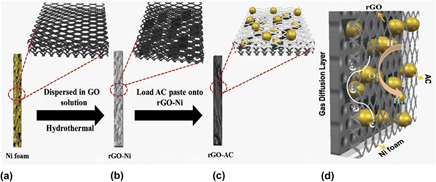Article contents
Reduced graphene oxide modified activated carbon for improving power generation of air-cathode microbial fuel cells
Published online by Cambridge University Press: 08 August 2017
Abstract

Activated carbon (AC) has been widely used as catalyst for oxygen reduction reaction (ORR) in air-cathode microbial fuel cells (MFCs). Here we demonstrate a new method to improve the AC air-cathode by blending it with reduced graphene oxide (rGO). rGO sheets are first deposited on Ni foam and AC is then brushed onto it with controlled mass loading. rGO sheets not only improve the electrical conductivity of AC, but also provide a large number of ORR areas. Rotating ring disk electrode measurements reveal that the number of transferred electrons at rGO-AC cathode is 3.5, indicating the four-electron pathway is the dominant process. Significantly, the MFC with rGO-AC cathode delivers a maximum power density of 2.25 ± 0.05 W/m2, which is substantially higher than that of plain AC cathode (1.35 ± 0.07 W/m2) and those for other air-cathode MFCs using AC as ORR catalyst under the same mass loading.
Keywords
- Type
- Invited Article
- Information
- Journal of Materials Research , Volume 33 , Issue 9: Focus Issue: Porous Carbon and Carbonaceous Materials for Energy Conversion and Storage , 14 May 2018 , pp. 1279 - 1287
- Copyright
- Copyright © Materials Research Society 2017
Footnotes
Contributing Editor: Teng Zhai
References
REFERENCES
- 8
- Cited by





